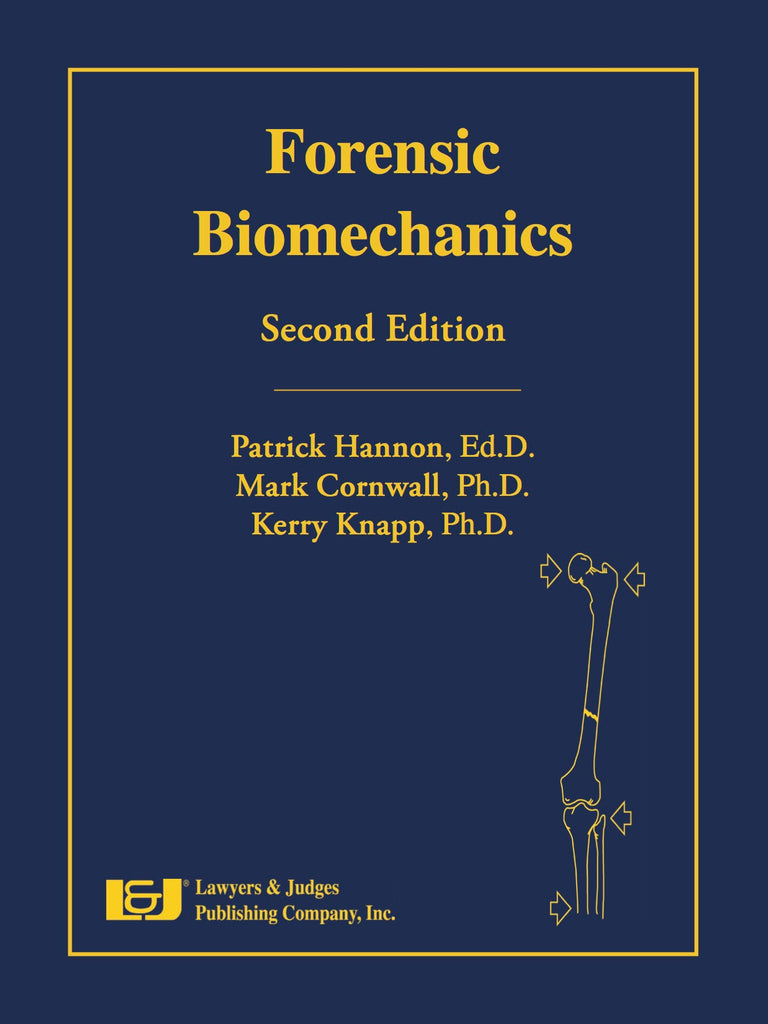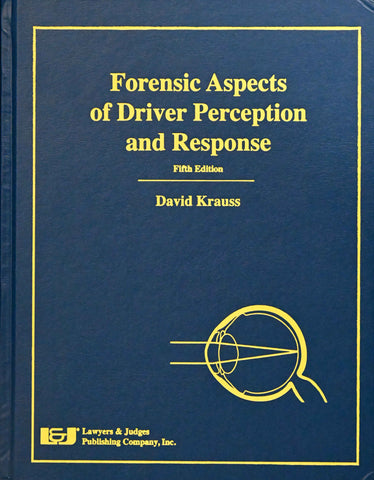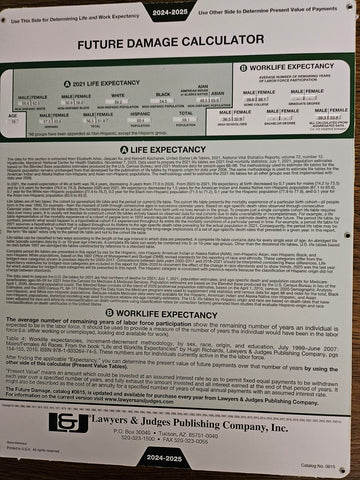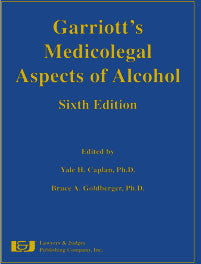
Forensic Biomechanics, Second Edition with DVD
- Authors: Patrick Hannon, Mark Cornwall, Kerry Knapp; Contributors: Scott Anderson, David Bosch, Michael Iliescu, Robert Perry
- ISBN 10: 978-1-936360-75-8
- ISBN 13: 1-936360-75-6
- Copyright Date Ed: Jan. 1, 2020
- Pages: 416 pages
- Binding Information: Hardcover plus DVD
- Size: 8.25 ✕ 11 Inches (US)
This new reference explains the role of biomechanics, the study of the mechanics of the living body, and the forces acted upon it, in accident and injury cases. This book gives you an in-depth look at the area of human injury biomechanics. It also discusses the role of the biomechanist and when and how he or she can help with your investigation. The authors discuss biomechanical causation versus medical causation, the basic principles of biomechanics, approaches to the use of biomechanics in investigation, and application of biomechanical principles to impact injuries. They also provide detailed information on the biomechanics of the human body including bone tissue, articular cartilage, soft tissue, blood and fluids, spinal cord and nerve tissue, joints, and extremities.
This book contains over 300 diagrams and images plus a DVD of cadaver photos illustrating the principles discussed. This book is invaluable if you are working on an accident or injury case, and need to understand the principles of the biomechanics behind the injury.
Topics Include:
- Overview of Biomechanics of Injury
- Basic Principles of Biomechanics
- Impacts
- Bone Tissue
- Soft Tissue and Bodily Fluids
- Articular Cartilage
- The Spinal Cord and Nerves
- The Head, Face, and Brain
- The Torso and Thorax
- The Cervical and Lumbar Spine
- Joints
- Extremities
Table of Contents
Preface
Chapter 1: Introduction
Kerry Knap
1.1 What Is Biomechanics and Injury Biomechanics
1.2 Who Are Biomechanists? What Is Their Role?
A. Biomechanics: A scientific discipline
B. Biomechanical causation versus medical causation
1.3 How to Work with a Biomechanist: A Low Impact Example
1.4 When Can a Biomechanist Help?
1.5 Some Non-Automotive Examples
Chapter 2: The Analytical Approach
Kerry Knapp
2.1 Introduction
2.2 Statement of Problem
2.3 Mental Models and Situation Awareness
2.4 The General Decision Tree Mode
A. Application 1: The low-speed motor vehicle accident
B. Application 2: Gunshot death
2.5 Conclusion
References
Chapter 3: Basic Principles of Biomechanics
Patrick Hannon
3.1 Introduction
3.2 Linear and Angular Movement
A. The anatomical position: Planes, axes, and movements
B. Vectors and scalars
3.3 Kinematics
A. Time
B. Position
C. Displacement
D. Linear and angular velocity
E. Linear and angular acceleration
F. Kinematic case examples
3.4 Kinetics
A. Characteristics of forces, moments, and torques
B. Classical mechanics
C. Special application of forces
3.5 Work and Energy
3.6 General Material Mechanics
A. Rigid body mechanics versus deformable solids
B. Material properties of biological materials
3.7 Functional Anatomy—Machines of the Body and Implication for Mechanisms of Injury
3.8 Summary
References
Recommended Reading
Chapter 4: The Application of Biomechanical Principles to Impacts
Patrick Hannon
4.1 Introduction
4.2 Falls
A. The impulse equation approach
B. The energy equation approach
4.3 Vehicle Impacts
A. Automobile impacts
B. Watercraft impacts
C. Aircraft impacts
D. Bicycle and motorcycle impacts
4.4 Pedestrian Impacts
A. Fender vault trajectory
B. Roof vault trajectory
C. Wrap trajectory
D. Forward projection trajectory
E. Somersault trajectory
4.5 Seat Belt Restraint Use in Vehicles
4.6 Air Bags and Air Curtains
A. Front air bags
B. Side air bags
4.7 Gunshot Wounds—Ballistics Impact/Penetration Trauma
A. Internal ballistics
B. Missile mass and speed (external ballistics)
C. Wound (terminal) ballistics
4.8 Explosions/Blasts
A. Physics of explosions
B. The blast wave
C. High temperature effects and quaternary blast injuries
References
Chapter 5: Biomechanics of Bone Tissue
Patrick Hannon
5.1 Bone Growth and Development
5.2 Function of Bones
5.3 Biological Properties of Bones
5.4 Material Properties of Compact and Cancellous Bone
5.5 Bone Anisotropy
5.6 Ductile and Brittle Properties of Bone
5.7 Bone Stiffness
5.8 Bone Viscoelasticity
5.9 Bone Fracture-Failure Behavior in Response to Loading
5.10 Direct and Indirect Loading
5.11 Combined Loading
5.12 Bone Geometry Affects Fracture Failure
5.13 Failure at the Epiphyseal Growth Plate
5.14 Other Fractures
5.15 Stress Risers and Open Section Defects
5.16 Bone Unloading
5.17 Chronic Loading Bone Failure
5.18 Degenerative Changes in Bone Caused by Aging
5.19 Fracture Fixation and Healing: Biomechanical Considerations
References
Chapter 6: Biomechanics of Articular Cartilage
Patrick Hannon
6.1 Introduction
6.2 Elastic Cartilage
6.3 Articular Cartilage
A. Overview of the structure of articular cartilage
B. Articular cartilage components and material properties
6.4 Lubrication of Articular Cartilage Surfaces
6.5 Effect of Loads and Stresses
6.6 Deformable Bearings and Stress Relaxation
6.7 Biomechanical Factors Involved in Articular Cartilage Degeneration
References
Chapter 7: Soft Tissue Biomechanics: Tendons, Ligaments, Muscle and Skin; Blood Fluid Dynamics
Patrick Hannon
7.1 Introduction
7.2 Tendon and Ligament Development, Structure, and Physiology
A. Tendon and ligament tissue healing
B. Material properties of ligaments and tendons
7.3 Skeletal Muscle Development, Structure and Physiology
A. Muscle tissue healing
B. Material properties of skeletal muscle tissue
7.4 Skin Development, Structure, and Physiology
A. Skin tissue healing
B. Material properties of skin tissue
7.5 Vasculature and Blood
A. Vasculature structure and material properties
B. Blood fluid dynamics
C. Blood spatter analysis
7.6 Anisotropic and Viscoelastic Behavior
A. Anisotropic behavior
B. Viscoelastic behavior
References
Chapter 8: Biomechanics of Spinal Cord, Nerve Roots, and Peripheral Nerve
Patrick Hannon
8.1 Introduction
8.2 Anatomy of the Spinal Cord and Nerve Roots
8.3 Anatomy of Peripheral Nerve
8.4 Microanatomy and Physiology of Neuron Axons. 122 8.5 Spinal Cord Loading
A. Penetration
B. Compression
C. Shear
8.6 Specific Spinal Cord Injuries
A. Anterior cord syndrome
B. Central cord syndrome
8.7 Nerve Root Loading—Tension, Compression, and Shear
8.8 Peripheral Nerve Loading
A. Tension
B. Compression
8.9 Peripheral Nerve Injury
A. Categories of peripheral nerve injury
B. Multiple levels of peripheral nerve compression
References
Additional Reading
Chapter 9: Head, Face, and Brain
Patrick Hannon
9.1 Introduction
9.2 Structural Anatomy of the Head
A. Scalp anatomy
B. Face and skull anatomy
C. Brain anatomy
9.3 Loading to Head, Face, and Brain
A. Scalp loading
B. Loading of the face and skull
C. Energy absorption during facial fracture
D. Classification of facial fractures
E. Other facial injuries
F. Skull and facial bone loading and brain injury
G. Infant skull and brain injury
H. Brain loading and traumatic brain injury
9.4 Mechanisms of Traumatic Brain Injury (TBI)
A. Penetration
B. Linear head acceleration: coup and contrecoup contusions
C. Angular head acceleration
9.5 Mild brain injury
9.6 Closing Comments—Brain Injury
9.7 Protection of the Skull, Face, and Brain Using the Appropriate Helmet
A. Helmet protection—general comments
B. Bicycle helmet protection
9.8 Air Bag Protection in Automobiles
References
Recommended Reading
Chapter 10: Torso and Thorax
Patrick Hannon and Michael Iliescu
10.1 Introduction
10.2 Classifying Injury Severity
10.3 Thorax
10.4 Thoracic Anatomy and Mechanisms of Injury
A. Ribs and sternum
B. Heart
C. Thoracic aorta
D. Thoracic vena cava (inferior and superior)
E. Trachea, bronchi, and lungs
F. Diaphragm
10.5 Iatrogenic (medically induced) injuries of the torso organs
10.6 Biomechanics and Injury Tolerance of the Thorax
10.7 Restraint Systems and Experimental Modeling
10.8 Abdomen
10.9 Abdominal Anatomy and Mechanisms of Injury
A. Liver
B. Spleen
C. Kidneys
D. Adrenal glands
E. Pancreas
F. Stomach
G. Small intestine
H. Large intestine
I. Abdominal wall
J. Gall bladder
K. Urinary bladder
L. Female reproductive organs
M. Major abdominal vessels
10.10 Biomechanics and Injury Tolerance of the Abdomen
10.11 Biomechanics and Injury Tolerance of the Male Reproductive System
A. Accident trauma loading
B. Loading to the perineum from bicycling activity
References
Recommended Reading
Chapter 11: Biomechanics of the Cervical Spine
Patrick Hannon
11.1 Introduction
11.2 Structural and Functional Anatomy of the Cervical Spine
A. Bony elements
B. Intervertebral Joints
C. The cervical spine intervertebral disk
D. Ligaments of the cervical spine
E. Neurovascular structures in the cervical region
F. Cervical spine musculature
11.3 Loading to the Cervical Spine Elements
A. Direct impact, crush, lacerations, and penetrations
B. Indirect loading
11.4 Cervical Spine Trauma
A. Bony elements
B. Soft tissues of the cervical spine
11.5 Tolerance Limits of Cervical Spine Tissues
A. Bone elements
B. Ligaments and joints
C. The cervical intervertebral disk
D. Muscle and tendon tissue
11.6 Cervical Spine—Sources of Pain
A. Bone tissue and pain
B. Joints—ligamentous and capsular pain
C. Discogenic pain
D. Muscle and myofascial pain
E. Neural structures of the cervical spine
References
Recommended Reading
Chapter 12: Lumbar Spine
Patrick Hannon
12.1 Introduction
12.2 Structural and Functional Anatomy of the Lumbar Spine
A. Bony elements
B. Intervertebral joints
C. The lumbar intervertebral disk
D. Ligaments of the lumbar spine
E. Neurovascular structures of the lumbar region
F. Lumbar spine musculature
12.3 Loading to the Lumbar Spine Elements
A. Direct loading
B. Indirect loading
12.4 Lumbar Spine Trauma
A. Bony elements (fracture failure) and the intervertebral joints
B. Soft tissues of the lumbar spine
12.5 Lumbar Spine Tolerance Limits
A. Bony elements
B. Ligaments and joints
C. The intervertebral disk
D. Muscle and tendon tissue
E. Neural structures
12.6 Lumbar Spine Sources of Pain
A. Bony structures
B. Joints—ligamentous and capsular pain
C. The intervertebral disk
D. The intervertebral disk in asymptomatic people
E. Muscle tissue
F. Neural structures
References
Recommended Reading
Chapter 13: The Shoulder
Mark W. Cornwall
13.1 Introduction
13.2 Anatomy of the Shoulder
A. Bones and joints of the shoulder
B. Major ligaments of the shoulder
C. Muscles and available movements of the shoulder
D. Nerves and arteries of the shoulder
13.3 Injuries to the Shoulder
A. Peripheral nerve injuries
B. Shoulder impingement
C. Rotator cuff tear
D. Sprains
E. Dislocations
F. Fractures
13.4 Case Studies
A. Shoulder dislocation
B. Humeral fracture
References
Recommended Reading
Mark W. Cornwall
14.1 Introduction
14.2 Anatomy of the Elbow
A. Bones and joints of the elbow
B. Major ligaments of the elbow
C. Muscles and available movements of the elbow
D. Nerves of the elbow
14.3 Elbow Injuries
A. Overuse
B. Sprains
C. Fractures
14.4 Case Study
References
Recommended Reading
Chapter 15: The Wrist and Hand
Mark W. Cornwall
15.1 Introduction
15.2 Anatomy of the Wrist and Hand
A. Bones and joints of the wrist and hand
B. Major ligaments of the wrist and hand
C. Muscles and available movements of the wrist and hand
D. Nerves and arteries of the wrist and hand
15.3 Injuries of the Wrist and Hand
A. Overuse
B. Sprains
C. Degeneration
D. Nerve injuries
E. Fractures
15.4 Case Studies
A. Finger fracture
B. Thumb dislocations
C. “Swan Neck” deformity
References
Recommended Reading
The Human Lower Extremity
Chapter 16: Anatomy of the Pelvis and Hip
Mark W. Cornwall
16.1 Introduction
16.2 Anatomy of the Pelvis and Hip
A. Bones and joints of the pelvis
B. Major ligaments of the pelvis
C. Muscles and available movements of the pelvis
D. Nerves and arteries of the pelvis
16.3 Anatomy of the Hip
A. Bones and joints of the hip
B. Major ligaments of the hip
C. Muscles and available movements of the hip
D. Nerves and arteries of the hip
16.4 Injuries to the Pelvis and Hip
A. Congenital disorders
B. Nerve injuries
C. Labral injuries
D. Fractures and dislocations
E. Degeneration
16.5 Case Studies
A. Acetabular fracture
B. Pelvis and femur fracture References
Recommended Reading
Chapter 17: The Knee
Mark W. Cornwall
17.1 Introduction
17.2 Anatomy of the Knee
A. Bones and joints of the knee
B. Major ligaments of the knee
C. Muscles and available movements of the knee
D. Nerves and arteries of the knee
17.3 Knee Injuries
A. Overuse
B. Sprains
C. Dislocations
D. Fractures
E. Degeneration
17.4 Case Studies
A. ACL injury
B. Tibial plateau fracture
References
Recommended Reading
Chapter 18: The Foot and Ankle
Mark W. Cornwall
18.1 Introduction
18.2 Anatomy of the Ankle
A. Bones and joints of the ankle
B. Major ligaments of the ankle
C. Muscles and available movements of the ankle
18.3 Anatomy of the Foot
A. Bones and joints of the foot
B. Major ligaments of the foot
C. Muscles and available movements of the foot
18.4 Nerve and Arteries of the Ankle and Foot
18.5 Ankle and Foot Injuries
A. Overuse
B. Sprains
C. Fractures
18.6 Case Studies
A. Lateral ankle injury
B. Calcaneal fracture
References
Recommended Reading
Chapter 19: A Brief Summary of Neurophysiology and Muscle Activity
Patrick Hannon
19.1 Introduction
19.2 Neuron and Muscle Cell Physiology
19.3 Muscle Tension Forces
A. Voluntary skeletal muscle contraction
B. Reflexive skeletal muscle activity
References and Recommended Reading
Chapter 20: Anatomical Mechanics—A Concept and Quantitative Approach: Bones, Joints, and Muscles
Patrick Hannon
20.1 Types of Joints
20.2 Human Machines
20.3 Moments and Torques
20.4 Muscle Force Resolution
20.5 Muscle Force Composition
20.6 Moments in Static and Dynamic
References
Chapter 21: The Biomechanics, Engineering Design and Failure Analysis of Implantable Medical Devices—An Overview
David Bosch, Scott Anderson and Patrick Hannon
21.1 Introduction
21.2 General Discussion and Types of Implants
21.3 Engineering and Biomechanical Considerations in Orthopedic Implants
A. Objectives and benefits of orthopedic implants
B. Biocompatibility of materials
C. Resistance to fatigue and corrosion
D. Fixation between the implant and bone: biomechanical considerations
E. Orthopedic implant design and modularity
21.4 Review of Mechanics of Materials
A. Rigid body mechanics versus deformable solids
B. Material properties of engineering biological materials
21.5 Failure Analysis and Prevention
21.6 Materials Failure Analysis and Testing Techniques and Tools
A. Metallographic techniques—optical metallography
B. Scanning electron microscopy (SEM)
C. Energy dispersive x-ray spectrometry (EDS)
D. Electron probe x-ray microanalysis—wavelength dispersive x-ray
spectrometry (WDS)
E. Arc spark optical emission spectroscopy (spark OES)
F. Hardness testing
21.7 Fractography
A. Dimple rupture fracture
B. Fatigue fracture
C. Cleavage fracture
References
Recommended Reading
Appendix A: Anthropometric Measurements
Patrick Hannon
Appendix B: Conversion Factors
Patrick Hannon
Appendix C: Instrumentation in Biomechanics
Patrick Hannon
C.1 Introduction
C.2 Measurement of Kinematics
A. Surveillance video
B. High speed laboratory grade video
C. Optoelectric systems
D. Magnetic field systems
C.3 Measurement of Kinetics
A. Force plates
B. Coefficient of friction testing
C. Accelerometry
D. Strain gauge cable tensiometers
E. Electromyography (measures of muscle activity
References
About the Authors
About the Illustrator
Index



